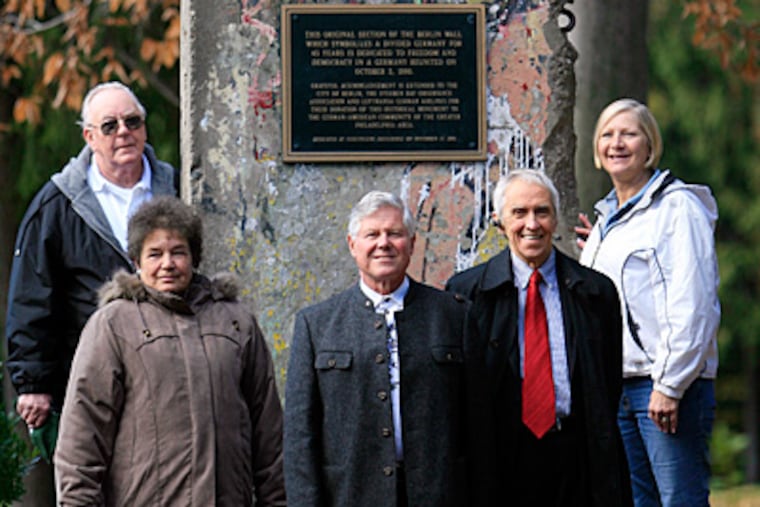20 years later: How Bucks got section of Berlin Wall
A section of the Berlin Wall stands on a pedestal in a quiet glen of trees in Warminster, Bucks County, its countenance marked with history.

A section of the Berlin Wall stands on a pedestal in a quiet glen of trees in Warminster, Bucks County, its countenance marked with history.
One side of the concrete monolith is blank; between 1961 and 1989, barbed wire, snarling dogs, and armed guards kept East Berliners from coming close.
On the other are paint scrawls in red, yellow, orange, and black left by West Berliners angry because the wall separated them from countrymen and, often, family.
"A lot of people vented on this wall," said Carol Ebinger of Collingdale, Delaware County, who viewed the piece of the wall Friday outside a German society clubhouse where she's a member. "They are expressions of outrage."
Today, exactly 20 years after the Berlin Wall fell, uniting East with West Berlin and paving the way for a unification of Germany in 1990, millions of German Americans look to the past.
About 70 million Americans trace their ancestry to Germany, said Louis Oschmann, president of the German American Committee of Philadelphia, which acts as an umbrella group for local German societies.
Members of the Vereinigung Erzgebirge, the largest of a half-dozen German American clubs in the Delaware Valley, attended a special concert Sept. 29 in Washington to commemorate the 19th anniversary of the German unification.
While no special ceremony is planned today, club members will use the occasion to recall how the section of the wall reached the United States.
The German Embassy gave permission for the segment's release once 100 unemployed East Germans were given jobs in America.
It was displayed in Philadelphia's Steuben Day Parade in 1990. Lufthansa Airlines flew the piece, which weighed five tons, to Philadelphia International Airport for free.
"The segment was loaded by forklift onto an airport cargo trailer, which immediately blew out all four tires," William Aust, vice president of the club, said with a smile.
U.S. Customs and Department of Justice officials refused to release the concrete slab until Bruno Karnas, now club president, put up his house as collateral to ensure that the slab wouldn't be hacked into pieces and sold.
At that time, Aust said, fragments of the wall were fetching $20 and more.
A Ford dealership in Langhorne supplied a truck hefty enough to carry the slab in the parade.
"During the parade, a squad of officers accompanied the wall, so that adventurous spectators with chisel and hammer would not further chip away at the wall," Aust said. "It had great commercial value as a keepsake."
After the parade, the segment was moved to Northeast Philadelphia, where it was put on display as part of the Bavarian FolkFest Club's Oktoberfest. Again, it had a police escort.
Later, because no appropriate setting was available, the piece of the wall was driven to a farm in Bucks County, where it stayed hidden in a hay barn for a year, Aust said.
"Not even Bruno Karnas knew where it was hidden," said Aust, a German teacher from Lahaska.
There are slabs of the Berlin Wall in Montreal, California, Florida, and Illinois, though the first was here, Aust said.
German Americans chose the Vereinigung Erzgebirge to house the wall segment because the club's founders came from the Erzgebirge, in the state of Saxony, along the border with the Czech Republic, Aust said.
"And this is the only place that agreed to take it that had room," said William Ebinger, Carol's husband.
The club raised $40,000 to place the segment on a base in a shady plaza with walkways and a waterfall. The monument was dedicated in 1991 with a plaque that reads: "For 28 years a symbol of the iron curtain."
Club members know it's there and pass by it often, but the slab remains largely invisible to the public.
That must change, said Al Taubenberger, chairman of the Steuben Day Observance Association of Philadelphia, and a 2007 mayoral candidate in Philadelphia.
"It should be more known," he said, "because it is truly something special."